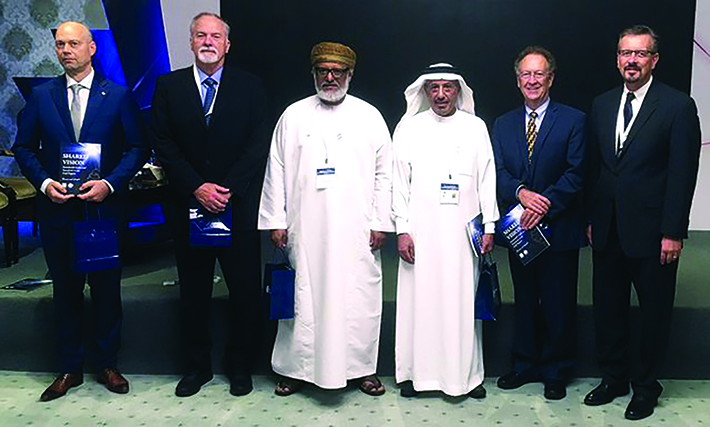
Outreach: Building Relationships
CEN and ASTM International Sign Technical Cooperation Agreement
On Sept. 26, CEN, the European Committee for Standardization, and ASTM International signed a Technical Cooperation Agreement to support global dialogue and coordination in specific standardization areas of mutual interest.
The agreement establishes a framework for technical cooperation and information exchange between the two standards organizations.
Katharine Morgan (left), president, ASTM International, and Elena Santiago Cid, general director, CEN, signed a memorandum of understanding on Sept. 27 in Brussels, Belgium.
Through this agreement, CEN and ASTM International have agreed to a series of practical implementation actions, specifically in those technical areas where there is common interest between ASTM International and CEN. These actions include:
- Exploring opportunities to collaborate within each organization’s respective standards development process;
- Facilitating technical standardization dialogue between their technical bodies; and
- Sharing information on their standards development activities and emerging technologies, trends, or regulatory drivers of mutual interest for the benefit of the stakeholders.
As a first step in their cooperation, CEN and ASTM International will establish a pilot involving technical groups of common interest.
The CEN groups include:
- Technical committee 411, biobased products, whose secretariat is held by the Netherlands Standardization Institute (NEN), and
- Technical committee 366, materials obtained from end-of-life tires, whose secretariat is held by the Ente Nazionale Italiano di Unificazione (UNI).
The ASTM International groups include:
- The committee on plastics (D20), with a focus on environmentally degradable plastics and biobased products, and
- The committees on recovered carbon black, rCB (D36) and rubber and rubber-like materials (D11), with a focus on tires and rubber products that can use rCB.
Katharine Morgan, president of ASTM International, said, “CEN and ASTM International are two of the most relevant and robust standards organizations in the world. Our agreement promotes greater coherence and interoperability in today’s global marketplace and fosters deeper understanding and trust among leading technical experts that will lay the foundation for future cooperation.”
“I’m thrilled to see this new collaboration in key technical areas that support circular economy goals and global trade,” commented Taco van der Maten, marketing manager at Malvern Panalytical in the Netherlands, who is serving as ASTM International’s 2019 board chair. “Our stakeholders stand to benefit from a deeper understanding of technical challenges and more common approaches to standards development. It’s exciting to see what can be accomplished.”
Elena Santiago Cid, director general of CEN, said, “The agreement with ASTM is an example of our efforts to establish fruitful partnerships with fellow standards organizations to promote global market access for European industry and stakeholders. This agreement enables a focused cooperation in the development of standards to bring benefits to those players committed to fair competition in the global economy.”
SWEP chapter meeting attendees included (from left): Molly Lynyak, manager, technical committee operations, ASTM; Joan Lawrence, senior vice president, The Toy Association; Terry Woods, Ph.D., ASTM board member; and Eileen Snyder, technical sales/regulatory affairs at Alpha Analytical.
ASTM International Hosts Philadelphia Chapter of Society of Women Environmental Professionals
ASTM International hosted a meeting of the Society of Women Environmental Professionals of Greater Philadelphia on Sept. 5. Katharine Morgan, ASTM president, delivered opening remarks.
In her presentation, Morgan spoke about the recent history of ASTM International and described its current mission and work. The presentation included information on the work of recently formed committees and described how ASTM standards figure into the work of environmental sustainability.
Morgan concluded her presentation by debuting a new video featuring four women who are active in various technical committees.
ASTM International Funds Nine Research Projects for Additive Manufacturing Standards
On Sept. 17, ASTM International announced its second round of funding in support of research to help expedite standards for additive manufacturing (AM). This investment of $300,000 and in-kind contributions will support the ASTM International Additive Manufacturing Center of Excellence (AMCOE) goal of addressing pressing needs for technical standardization in this fast-growing industry.
“We are thrilled to fund some of the most crucial and high-impact research projects in additive manufacturing to accelerate standardization,” said Mohsen Seifi, Ph.D., ASTM’s director of global additive manufacturing programs, at a recent AMCOE workshop in Senlis, France. He added that these nine projects will complement the previous round of five, with all contributing to fill standards gaps in design, feedstock, process, post-processing, testing, and qualification.
This round of projects has been approved by the subcommittee focused on research and innovation (F42.90.05), part of the committee on additive manufacturing technologies (F42). The projects target diverse topics.
Auburn University will work to implement a rapid, efficient, and effective inspection process to detect potential part quality issues after fabrication through laser powder bed fusion (L-PBF). The study aims to identify and quantify deviations in build and material quality through a series of tests performed within a few hours after the part is removed from the 3D printer.
In addition, Auburn University and NASA will partner to continue work from Phase l of a previously funded project that developed consensus regarding the minimum requirements for qualifying L-PBF machines and processes. In Phase ll, the team will establish qualitative and quantitative metrics for evaluation methods, conduct round-robin trials, and establish recommendations for standards implementation.
Applied technology developer EWI aims to leverage overall advances in digital data acquisition, automation, and data analysis. EWI will work to define a minimum subset of AM data entries and a taxonomy of those entries. The resulting standard will help establish best practices for data sharing, a common data dictionary for AM, and a data-management roadmap that integrates stakeholder needs.
The United Kingdom-based Manufacturing Technology Centre (MTC) will address the lack of guidelines for what is deemed an acceptable test result in powder feedstock test methods. This operator proficiency study, which will leverage findings from ASTM International’s AM Proficiency Testing Program, aims to help stakeholders understand acceptable test results as well as typical variations in results from different labs.
In an additional project, MTC will work to address the growing number of post-processing issues tied to inefficient designs, cost, high nonconformity, and scrap rates. MTC will develop a guide that proposes best practices in design for each type of post-processing operation, with each topic possibly being further developed by research or standardization.
Singapore’s National Additive Manufacturing Innovation Cluster (NAMIC) will use off-axial monitoring to acquire optical and thermal images from the laser powder bed fusion process. Image analysis will allow NAMIC to extract structured data, ultimately helping to develop a procedure to construct a three-dimensional file embedding with parameters representing both the printing process and quality evaluation.
Additionally, NAMIC will conduct research to develop guidelines and best practices specific to directed energy deposition and material extrusion, two processes of great interest to manufacturers and designers. These guides will provide an overall document structure and guidelines for standard development.
Wichita State University’s National Institute for Aviation Research (NIAR) will gather information from existing polymer characterization activities to create a test plan and matrix incorporating the state of the art for these testing methods. Additional print, test, and analysis will be conducted to generate additional data. NIAR will share results and develop appropriate documentation based on its findings.
NIAR will also study coupon-part property relationships in additively manufactured polymers. They will review results from multiple studies to compile an approach for microstructural analysis of specimens as well as application-specific characterization. Additional print, test, and analysis will be conducted before standards are pursued.
For more information about the AMCOE and additional project details, visit AMCOE.org.
ASTM Vice President Attends UNECE Meeting in South Africa
During a trip to South Africa in September, Teresa Cendrowska, vice president of global cooperation at ASTM International, attended the United Nations Economic Commission for Europe’s (UNECE) meeting of signatories of the Declaration on Gender Responsive Standards and Standards Development. The purposes of the meeting were to exchange experiences in developing gender action plans and implementing initiatives for women’s empowerment and to decide future priorities of the initiative, based on current and newly proposed work items.
Katharine Morgan, president of ASTM International, signed the declaration during the ASTM International annual business meeting in Denver, Colorado, on May 14.
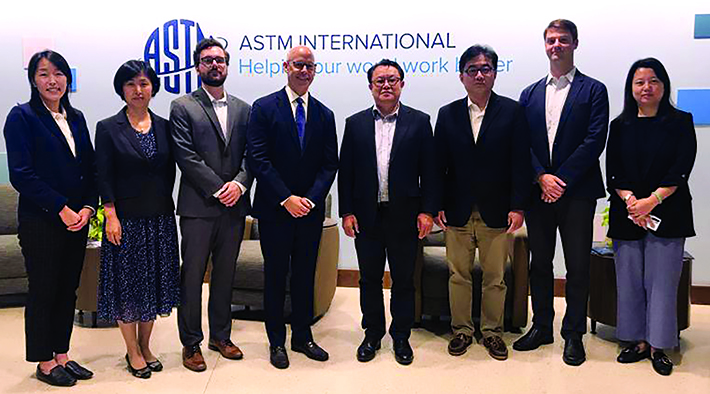
Representatives of the China National Pharmaceutical Packaging Association (CNPPA) visited ASTM International headquarters on Sept. 25 for meetings that included an overview of ASTM International, the structure of ASTM technical committees, and potential collaboration in the near future. From left: Weiwei Swei, manager of global cooperation, ASTM; Gao Yonghua, secretary general, CNPPA; James Farrell, manager, technical committee operations, ASTM; Brian Meincke, vice president of finance, business development, and innovation, ASTM; Wang Biao, vice president, CNPPA; Hua Xiong, adviser, CNPPA; Travis Murdock, manager, technical committee operations, ASTM, and Han Lin, director, CNPPA.
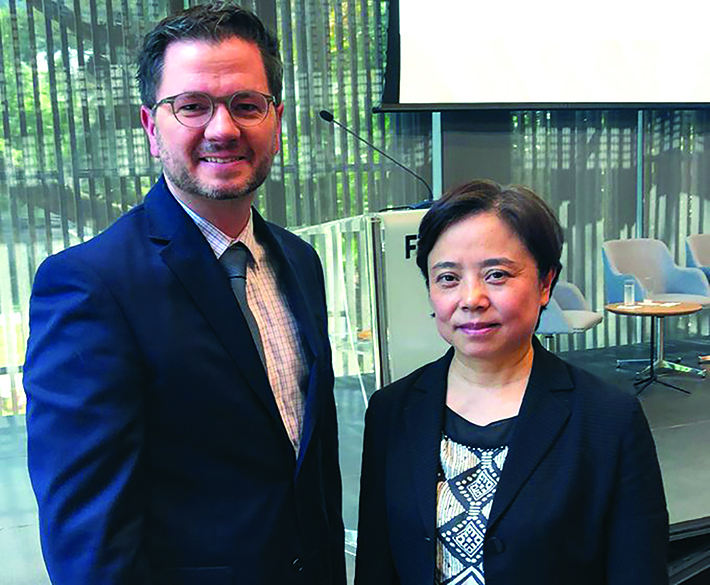
Nathan Osburn (left), director of communications, ASTM International, met with Liu Xin, director of the department of standards with the Standardization Administration of China (SAC), at the Second International Convention on Sustainable Trade: Sustainable Value Chains and Standards, in Rio de Janeiro, Brazil, on Sept. 17. ASTM and SAC signed a memorandum of understanding in 2004.
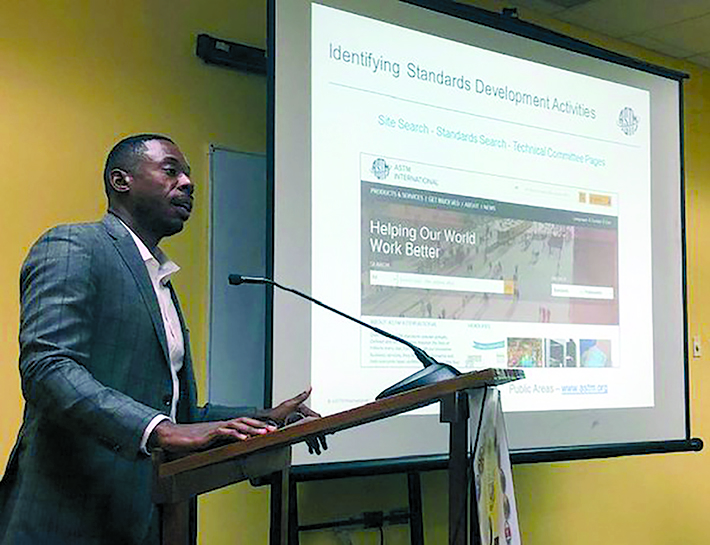
Anthony Quinn, director of public policy and international trade, ASTM International, gives a presentation on ASTM and the building industry on Oct. 2 at the 35th meeting of the Council of the Regional Organisation for Standards and Quality, hosted by the Trinidad and Tobago Bureau of Standards.

Taco van der Maten, ASTM International 2019 board chair and marketing manager, Malvern Panalytical, and James Olshefsky, director of external relations, ASTM, participated in the Standards and Codes for Sustainable Construction closing ceremony in Kuwait on Sept. 25. From left: van der Maten; David Walls, vice president of business support initiatives, International Code Council; Saoud Nasser Mansoor Al-Khusaibi, secretary general, GCC Standards Organization; Ahmed B. Shuraim, governor’s adviser, Saudi Standards, Metrology, and Quality Organization; R. Christopher Mathis, president of Mathis Consulting; and Olshefsky.
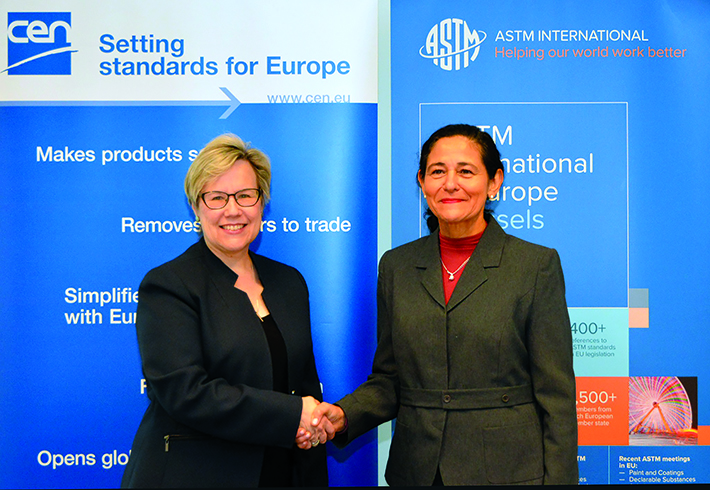
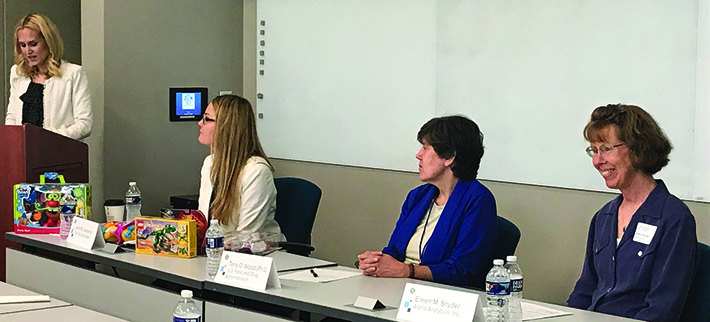
 SN Home
SN Home Archive
Archive Advertisers
Advertisers Masthead
Masthead RateCard
RateCard Subscribe
Subscribe Email Editor
Email Editor